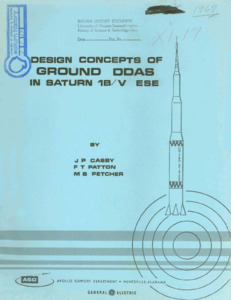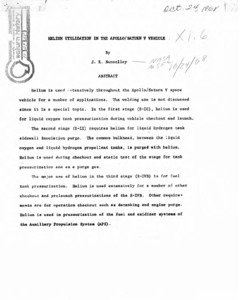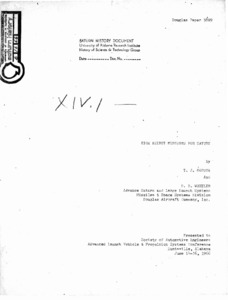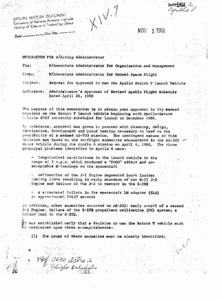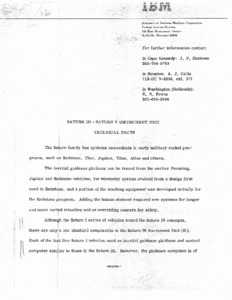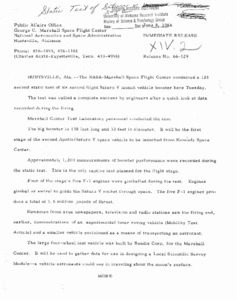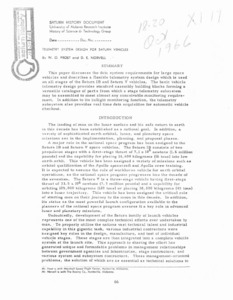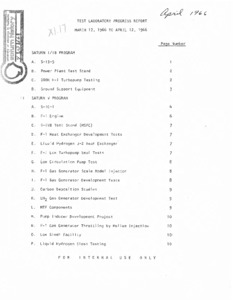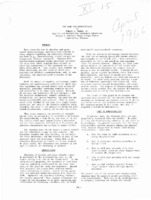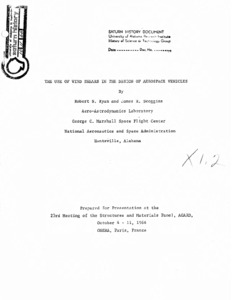
Browse Items (44 total)
Sort by:
-
"Design Concepts of Ground DDAS in Saturn 1B/V ESE."
In the Saturn IB/V programs the sheer quantity of data required for computer processing and ESE display makes it necessary to provide an efficient data acquisition system. For much of the data originating in the launcher this requirement is satisfied by the Ground Digital Data Acquisition System (DDAS). This paper provides a technical description of the Ground DDAS with emphasis placed on the unique design concepts of this telemetry system. -
"Helium Utilization in the Apollo/Saturn V Vehicle."
Helium is used extensively throughout the Apollo/Saturn V space vehicle for a number of applications. The welding use is not discussed since it is a special topic. In the first stage (S-IC), helium is used for liquid oxygen tank pressurization during vehicle checkout and launch. -
"High Energy Missions for Saturn."
Presented to Society of Automotive Engineers, Advanced Launch Vehicle & Propulsion Systems. When the Apollo lunar landing project is complete, the Saturn and Apollo hardware will only have begun to realize their ultimate potential for space exploration. The immense reserve of Apollo technology, facilities, and booster capability can then be directed to the achievement of national goals which lie far beyond the initial lunar landing. In achieving the Apollo lunar objectives, large investments will have been made in launch facilities, tracking systems, propulsion techniques, reentry systems, lunar landing systems and rendezvous technologies. Although developnent in these specialized areas has been tailored to the needs of Apollo, numerous studies by NASA and industry have demonstrated the feasibility of using the spacecraft, launch vehicles, and operating techniques for missions far more complex than lunar landings. Amortization of this hardware will prove cost-effective for missions of more sophisticated applications. -
"Request for approval to man the Apollo Saturn V Vehicle."
The purpose of this memorandum is to obtaln your approval to fly manned missions on the Saturn V launch vehicle beginning with Apollo-Saturn vehicle #503 currently scheduled for launch in December 1968. -
"Saturn IB - Saturn V instrument unit technical facts."
Press release detailing the technical aspects of the Saturn IB. -
"Static test of Saturn V S-IC : news release.
Report after second Saturn V flight test. -
"Telemetry system design for Saturn vehicles."
This paper discusses the data system requirements for large space vehicles and describes a flexible telemetry system design which is used on all stages of the Saturn IB and Saturn V vehicles. The basic vehicle telemetry design provides standard assembly building blocks forming a versatile catalogue of parts from which a stage telemetry subsystem may be assembled to meet almost any conceivable monitoring requirement. In addition to its inflight monitoring function, the telemetry subsystem also provides real time data acquisition for automatic vehicle checkout. -
"Test Laboratory progress report" March and April.
Monthly rogress report for the test laboratory regarding the Saturn 1B program between March and April. -
"The Case for Compatibility."
"The Case for Compatibility" is a paper by Robert L. Smith, Jr., who worked in Quality and Reliability Assurance Laboratory at George C. Marshall Space Flight Center. The summary states, "Ever since the use of missiles and space launch vehicles began, questions have existed in every program regarding the similarity between upstream (e.g., manufacturing, static firing ) and launch site checkout equipment. Programs have existed which utilized nearly identical equipment for both uses; other programs have existed in which any resemblance of the equipment was probably coincidental. Many factors have entered the final decisions, not the least of which were economic and schedule considerations, and, in some instances, the organizational structure of the developer." -
"The use of wind shears in the design of aerospace vehicles."
Prepared for presentation at the 23rd Meeting of the Structures and Materials Panel, AGARD, October 4-11,1966, ONERA, Paris, France.; ABSTRACT: The relative influence of various wind profile properties and disturbances on launch vehicle flight dynamic response is studied. Particular emphasis is placed on the influence of wind shears and turbulence on dynamic response during the boost phase of the flight. Four hundred and seven individual detailed (Jimsphere) wind profiles are the primary wind inputs for this analysis. Time response of the vehicle to each profile is computed and a statistical evaluation of the results made. Results are obtained for the Saturn V space vehicle and conclusions drawn as to the relative influence of wind shears and turbulence vs the degree of refinement of the dynamic model of the space vehicle.
